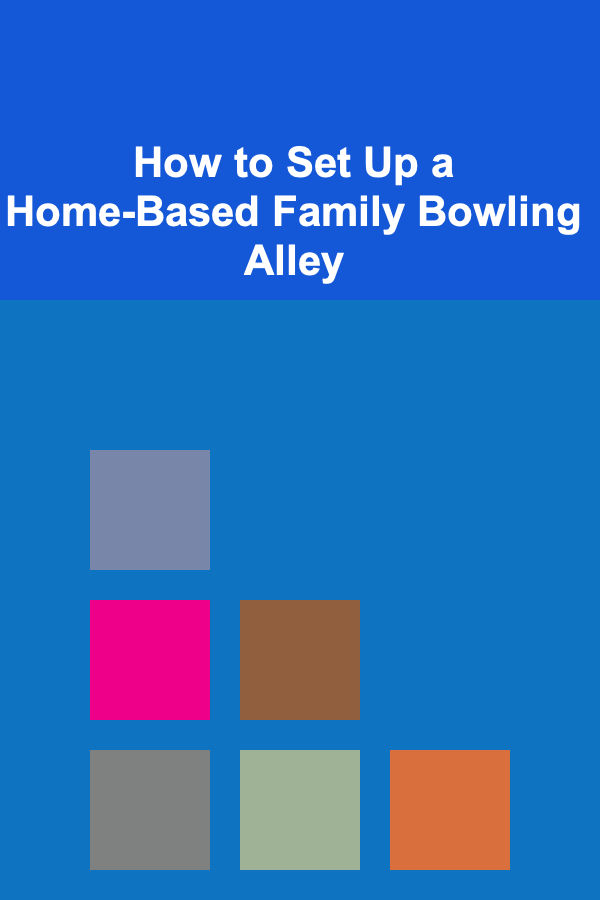
How to Set Up a Home-Based Family Bowling Alley
ebook include PDF & Audio bundle (Micro Guide)
$12.99$6.99
Limited Time Offer! Order within the next:

Bowling is a fun, competitive, and social activity that can bring people together, whether for family bonding, friendly competition, or simply a casual game night. While traditionally enjoyed in bowling alleys, creating a home-based family bowling alley can provide endless fun and entertainment, right at your doorstep. With the right space, equipment, and setup, you can turn your home into a personalized bowling center, suitable for both kids and adults.
In this article, we will explore the steps to setting up a home-based family bowling alley, from choosing the right location and gathering the necessary equipment, to designing the lane and creating the ultimate family experience. Whether you have a large basement, a spacious garage, or even a dedicated room, transforming it into a bowling alley can be a worthwhile project for both seasoned bowlers and beginners alike.
Assessing Your Space
The first step in creating a home-based family bowling alley is to assess the space you have available. Bowling alleys require a considerable amount of room, and the size of the lane you build will determine the overall feel of the setup.
1.1 Ideal Room Size
For a standard bowling lane, the typical length of a bowling lane is about 60 feet (18.29 meters). However, for a home setup, you can adjust this to fit your available space. For instance, a smaller, fun-sized lane might be around 30 feet (9 meters), which is still long enough for a decent game but may fit better in smaller rooms.
The width of the lane should ideally be about 41 inches (1 meter). A larger width allows for easier maneuvering of the ball, while a narrower lane can add a level of difficulty, increasing the challenge.
Additionally, you will need room behind the lane for the ball return system and seating. Ideally, you'll want a space that offers at least 15-20 feet behind the bowling lane for safe movement and seating arrangements.
1.2 Location Considerations
When selecting the location for your bowling alley, you should consider the following factors:
- Ceiling Height: A typical bowling ball is approximately 8.5 inches in diameter, and the ball travels down the lane with a certain speed and force. You'll need to ensure the ceiling height allows for a comfortable playing experience. A ceiling height of at least 8-10 feet is recommended for the best experience.
- Flooring: Bowling alleys typically have smooth, level surfaces that are easy for the ball to roll on. Ensure the area is flat and well-maintained, as uneven flooring can hinder the performance of the bowling ball. Hardwood or vinyl flooring is ideal, but even concrete or tiled surfaces can work well with proper lane coating.
- Ventilation: Bowling can be an active sport, so ensure there is sufficient ventilation, especially in smaller, enclosed areas like basements or garages. Installing a fan or ensuring that windows open can help maintain a comfortable atmosphere.
Choosing the Right Bowling Lane Equipment
Once you've selected your space, the next step is gathering the equipment you need to set up the bowling lane. While the items required for a home bowling alley are the same as those used in professional alleys, you can choose to opt for scaled-down versions or DIY alternatives for a more budget-friendly setup.
2.1 Bowling Lane
There are a few ways to create your bowling lane:
- Pre-Made Bowling Lanes: Some companies sell pre-made bowling lanes designed for home use. These are typically made from synthetic materials that mimic the feel and playability of a real bowling alley. These lanes can be purchased in various lengths and are easy to install, making them a great option if you want a hassle-free setup.
- DIY Lane Construction: For a more customized approach, you can build your lane using high-quality wood or laminate materials. You'll need a level surface and several layers of wood to create a sturdy, smooth lane. You can finish the lane with a coating designed specifically for bowling to give it a professional appearance and to ensure smooth rolling.
- Modular Lanes: Another option is modular bowling lanes. These are customizable and can be adjusted based on the space you have. Many of these come with interlocking panels that are easy to install and store.
2.2 Ball Return System
A ball return system is crucial for a home bowling alley. It helps retrieve the ball after each throw, saving time and preventing it from rolling out of reach. Ball return systems can be bought commercially, or you can build a DIY version. Here are your options:
- Commercial Ball Return System: These systems are designed to operate similarly to those found in professional bowling alleys. They consist of a ball track that runs down the lane, returning the ball to the player's starting position. While these systems are reliable, they can be expensive.
- DIY Ball Return System: If you're looking to save money, building your own ball return system is possible. This could be as simple as creating a sloped surface that allows the ball to roll back toward you. You could also use PVC piping or a conveyor system to return the ball after each roll.
2.3 Bowling Balls
While professional bowlers often have their own custom balls, for a home bowling alley, you'll need a variety of balls that are suitable for different ages and skill levels.
- Adult Balls: The standard bowling ball weighs between 8 to 16 pounds. If you have adults in the family, you should aim for a set that offers these standard weights. A few different options will allow for a more fun and versatile experience.
- Kids' Balls: For younger children or beginners, you'll want lighter balls that are easier to handle. You can find kids' bowling balls that weigh anywhere between 6 to 8 pounds. Smaller, child-friendly balls are available in various colors, making them appealing to kids.
- Bowling Ball Alternatives: If you're not interested in purchasing traditional bowling balls, you could use plastic or foam balls as an alternative. These are lighter and safer, particularly for children.
2.4 Bowling Pins
Bowling pins are another key component of the setup. While most home setups use standard-sized pins, there are a few options available to make the experience more interesting:
- Standard Bowling Pins: These are the same size and weight as the pins used in professional bowling alleys. Typically, they stand 15 inches tall and weigh around 3 pounds 6 ounces.
- Mini Bowling Pins: If you have limited space or want to add a fun twist, consider mini bowling pins. These are smaller in size, making them perfect for younger children or more compact lanes.
- Weighted Pins: Some people opt for weighted bowling pins that are more stable and harder to knock over. This could add difficulty to the game, particularly for advanced bowlers.
2.5 Bowling Alley Scoring System
A scoring system can help keep track of scores and add a more professional touch to your home bowling alley.
- Electronic Scoring System: Many commercial bowling alley systems have electronic scoring features, and you can buy systems designed for home use. These systems automatically calculate scores and display them on a monitor.
- Manual Scoring: If you're on a budget or enjoy a more hands-on experience, you can opt for manual scoring. Using a chalkboard or dry-erase board, you can write down scores after every turn. This can also be a great way to teach younger kids how to keep track of their own scores.
Enhancing the Experience with Extras
While the essentials like the lane, pins, and balls are necessary for a home bowling alley, adding a few extra features can elevate the overall experience.
3.1 Lighting
Good lighting is important for creating the right atmosphere and ensuring players can clearly see the pins and lane. Consider adding LED lights along the sides of the lane or even in the gutters. You can create a fun, colorful ambiance by using multicolored LED strips or setting up traditional bowling lane lighting.
3.2 Seating Area
When you're hosting family or friends for a bowling night, seating is key. You'll need enough seating for players and spectators. Consider adding comfortable chairs, a small couch, or even bleacher-style seating along the side of the lane. You can make the seating area feel like a real bowling alley by adding some flair with retro bowling-themed cushions or seating covers.
3.3 Music and Entertainment
Bowling and music go hand in hand. Create a playlist of fun and energetic songs to enhance the atmosphere. Many home bowling alley enthusiasts use Bluetooth speakers or even integrate music into their lane systems.
Additionally, consider installing a screen to show bowling-related games, scores, or even a live camera feed of the action for added excitement.
3.4 Bowling Alley Decor
To complete the look and feel of your home bowling alley, you might want to add some decor elements. Retro bowling signs, framed photos of famous bowlers, or vintage bowling alley posters can give the space a professional and fun vibe. If you're designing the space for kids, you could opt for a more playful and colorful design.
Final Considerations
Once your home-based family bowling alley is set up, you're ready to enjoy hours of fun with your family. However, it's important to maintain the lane, equipment, and space to ensure that everything continues to function properly:
- Lane Maintenance: Periodically clean the lane surface to ensure smooth ball movement. You can use special cleaning products designed for bowling lanes or a simple broom to remove debris.
- Equipment Care: Regularly check the ball return system, scoring system, and pins for damage or wear and tear. Be sure to replace any worn-out equipment to keep the game going smoothly.
- Space Safety: Keep the area free from obstacles and clutter to prevent accidents. Ensure that your bowling setup remains safe and enjoyable for all participants.
Conclusion
Setting up a home-based family bowling alley can be a rewarding project that brings endless entertainment to your household. By selecting the right space, gathering the necessary equipment, and incorporating fun and creative extras, you can create an exciting environment where family members of all ages can enjoy bowling together.
Whether you're looking for a full-scale professional setup or a more casual, fun-filled alley, there are plenty of ways to make your home bowling alley experience uniquely yours. With a little investment in the right equipment and thoughtful design, you'll have a family bowling alley that provides countless hours of joy for years to come.
Reading More From Our Other Websites
- [Personal Care Tips 101] How to Choose a Body Butter That Is Safe for Sensitive Areas Like the Face
- [Home Soundproofing 101] How to Soundproof a Floor from Upstairs Noise: Tips for Peaceful Living
- [Tie-Dyeing Tip 101] Tie-Dye Safety 101: A Parent's Guide to Kid‑Friendly Dyeing
- [Whitewater Rafting Tip 101] How to Choose the Perfect Paddle and Oar Set for Your River Adventures
- [Home Pet Care 101] How to Litter Train Your Kitten
- [Weaving Tip 101] Weave Your Way to Wellness: The Therapeutic Benefits of Structured Weaving Lessons
- [Personal Care Tips 101] How to Choose a Perfume for Your Wedding Day
- [Personal Investment 101] Creating Passive Income Streams with Automated Deep Learning Solutions
- [Home Family Activity 101] How to Host a Monthly Family-Themed Bake-Off Using Your Own Comic Book Inspiration
- [Tiny Home Living Tip 101] How to Convert a Shipping Container into a Luxury Tiny Home Retreat

How to Host a Family Cooking Night with Simple Recipes
Read More
How to Incorporate Traditional Holiday Colors into Your Home Decor
Read More
What Are the Most Effective Ways to Declutter Your Mind?
Read More
The Perfect Pairing: Craft Beer and Pizza Harmony
Read More
Restoring Degraded Wildlife Habitats: A Comprehensive Guide
Read More
10 Tips for a Keto Recipe Planner
Read MoreOther Products

How to Host a Family Cooking Night with Simple Recipes
Read More
How to Incorporate Traditional Holiday Colors into Your Home Decor
Read More
What Are the Most Effective Ways to Declutter Your Mind?
Read More
The Perfect Pairing: Craft Beer and Pizza Harmony
Read More
Restoring Degraded Wildlife Habitats: A Comprehensive Guide
Read More